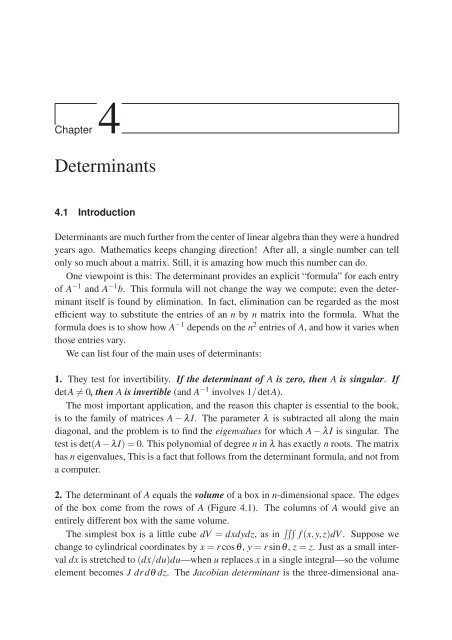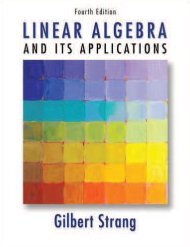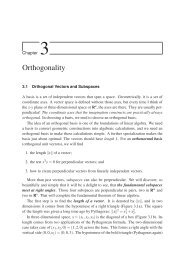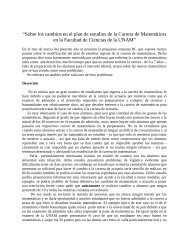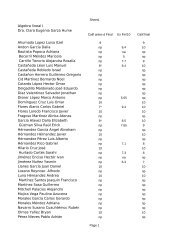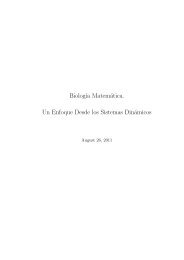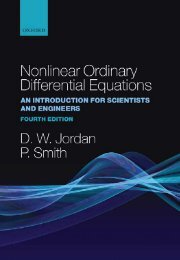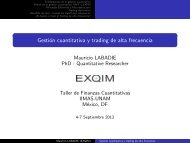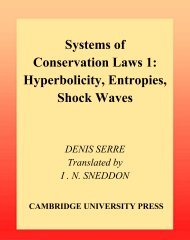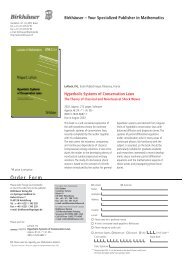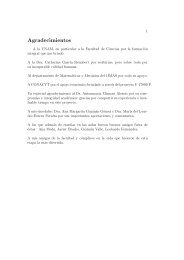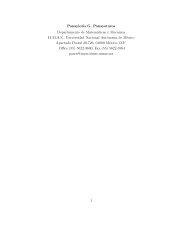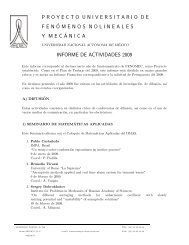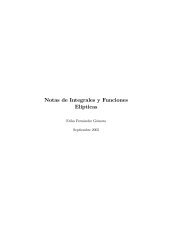Determinants - FENOMEC
Determinants - FENOMEC
Determinants - FENOMEC
You also want an ePaper? Increase the reach of your titles
YUMPU automatically turns print PDFs into web optimized ePapers that Google loves.
Chapter 4<strong>Determinants</strong>4.1 Introduction<strong>Determinants</strong> are much further from the center of linear algebra than they were a hundredyears ago. Mathematics keeps changing direction! After all, a single number can tellonly so much about a matrix. Still, it is amazing how much this number can do.One viewpoint is this: The determinant provides an explicit “formula” for each entryof A −1 and A −1 b. This formula will not change the way we compute; even the determinantitself is found by elimination. In fact, elimination can be regarded as the mostefficient way to substitute the entries of an n by n matrix into the formula. What theformula does is to show how A −1 depends on the n 2 entries of A, and how it varies whenthose entries vary.We can list four of the main uses of determinants:1. They test for invertibility. If the determinant of A is zero, then A is singular. IfdetA ≠ 0, then A is invertible (and A −1 involves 1/detA).The most important application, and the reason this chapter is essential to the book,is to the family of matrices A − λI. The parameter λ is subtracted all along the maindiagonal, and the problem is to find the eigenvalues for which A − λI is singular. Thetest is det(A−λI) = 0. This polynomial of degree n in λ has exactly n roots. The matrixhas n eigenvalues, This is a fact that follows from the determinant formula, and not froma computer.2. The determinant of A equals the volume of a box in n-dimensional space. The edgesof the box come from the rows of A (Figure 4.1). The columns of A would give anentirely different box with the same volume.The simplest box is a little cube dV = dxdydz, as in ∫∫∫ f(x,y,z)dV . Suppose wechange to cylindrical coordinates by x = r cosθ, y = r sinθ, z = z. Just as a small intervaldx is stretched to (dx/du)du—when u replaces x in a single integral—so the volumeelement becomes J dr dθ dz. The Jacobian determinant is the three-dimensional ana-
226 Chapter 4 <strong>Determinants</strong>z(a 31 , a 32 , a 33 )y(a 11 , a 12 , a 13 )(a 21 , a 22 , a 23 )xFigure 4.1: The box formed from the rows of A: volume = |determinant|.logue of the stretching factor dx/du:∂x/∂r ∂x/∂θ ∂x/∂zcosθ −r sinθ 0Jacobian J =∂y/∂r ∂y/∂θ ∂y/∂z=sinθ r cosθ 0.∣∂z/∂r ∂z/∂θ ∂z/∂z∣∣ 0 0 1∣The value of this determinant is J = r. It is the r in the cylindrical volume elementr dr dθ dz; this element is our little box. (It looks curved if we try to draw it, but probablyit gets straighter as the edges become infinitesimal.)3. The determinant gives a formula for each pivot. Theoretically, we could predictwhen a pivot entry will be zero, requiring a row exchange. From the formula determinant= ± (product of the pivots), it follows that regardless of the order of elimination,the product of the pivots remains the same apart from sign.Years ago, this led to the belief that it was useless to escape a very small pivot byexchanging rows, since eventually the small pivot would catch up with us. But whatusually happens in practice, if an abnormally small pivot is not avoided, is that it is verysoon followed by an abnormally large one. This brings the product back to normal butit leaves the numerical solution in ruins.4. The determinant measures the dependence of A −1 b on each element of b. If oneparameter is changed in an experiment, or one observation is corrected, the “influencecoefficient” in A −1 is a ratio of determinants.There is one more problem about the determinant. It is difficult not only to decideon its importance, and its proper place in the theory of linear algebra, but also to choose
4.2 Properties of the Determinant 227the best definition. Obviously, detA will not be some extremely simple function of n 2variables; otherwise A −1 would be much easier to find than it actually is.The simple things about the determinant are not the explicit formulas, but the propertiesit possesses. This suggests the natural place to begin. The determinant can be (andwill be) defined by its three most basic properties: detI = 1, the sign is reversed by arow exchange, the determinant is linear in each row separately. The problem is thento show, by systematically using these properties, how the determinant can be computed.This will bring us back to the product of the pivots.Section 4.2 explains these three defining properties of the determinant, and their mostimportant consequences. Section 4.3 gives two more formulas for the determinant—the“big formula” with n! terms, and a formula “by induction”. In Section 4.4 the determinantis applied to find A −1 . Then we compute x = A −1 b by Cramer’s rule. And finally, inan optional remark on permutations, we show that whatever the order in which the propertiesare used, the result is always the same—the defining properties are self-consistent.Here is a light-hearted question about permutations. How many exchanges does ittake to change VISA into AVIS? Is this permutation odd or even?4.2 Properties of the DeterminantThis will be a pretty long list. Fortunately each rule is easy to understand, and eveneasier to illustrate, for a 2 by 2 example. Therefore we shall verify that the familiardefinition in the 2 by 2 case,[ ]a bdet =a b= ad − bc,c d ∣cd∣ possesses every property in the list. (Notice the two accepted notations for the determinant,detA and |A|.) Properties 4–10 will be deduced from the previous ones. Everyproperty is a consequence of the first three. We emphasize that the rules apply tosquare matrices of any size.1. The determinant of the identity matrix is 1.∣ ∣∣∣∣∣∣ 1 01 0 0detI = 1∣0 1∣ = 1 and 0 1 0= 1 and...0 0 1∣
228 Chapter 4 <strong>Determinants</strong>2. The determinant changes sign when two rows are exchanged.∣ c d∣∣∣∣ Row exchange∣ab∣ = cb − ad = − acbd∣ .The determinant of every permutation matrix is detP = ±1. By row exchanges, we canturn P into the identity matrix. Each row exchange switches the sign of the determinant,until we reach detI = 1. Now come all other matrices!3. The determinant depends linearly on the first row. Suppose A, B, C are the samefrom the second row down—and row 1 of A is a linear combination of the first rows ofB and C. Then the rule says: detA is the same combination of detB and detC.Linear combinations involve two operations—adding vectors and multiplying by scalars.Therefore this rule can be split into two parts:∣ ∣ a+a ′ b+b ′∣∣∣∣ Add vectors in row 1∣ c d ∣ = a b∣∣∣∣ c d∣ + a ′ b ′c d∣ .Multiply by t in row 1∣ ta tb∣∣∣∣ ∣ c d ∣ = t acNotice that the first part is not the false statement det(B+C) = detB+detC. You cannotadd all the rows: only one row is allowed to change. Both sides give the answer ad +a ′ d − bc − b ′ c.The second part is not the false statement det(tA) = t detA. The matrix tA has a factort in every row (and the determinant is multiplied by t n ). It is like the volume of a box,when all sides are stretched by 4. In n dimensions the volume and determinant go up by4 n . If only one side is stretched, the volume and determinant go up by 4; that is rule 3.By rule 2, there is nothing special about the first row.The determinant is now settled, but that fact is not at all obvious. Therefore we graduallyuse these rules to find the determinant of any matrix.bd∣ .4. If two rows of A are equal, then detA = 0.aEqual rows∣ab= ab − ba = 0.b∣ This follows from rule 2, since if the equal rows are exchanged, the determinant is supposedto change sign. But it also has to stay the same, because the matrix stays the same.The only number which can do that is zero, so detA = 0. (The reasoning fails if 1 = −1,which is the case in Boolean algebra. Then rule 4 should replace rule 2 as one of thedefining properties.)
4.2 Properties of the Determinant 2295. Subtracting a multiple of one row from another row leaves the same determinant.∣ a −lc b −ld∣∣∣∣ Row operation∣ c d ∣ = a bc d∣ .Rule 3 would say that there is a further term −l ∣ c d∣ c d , but that term is zero by rule 4. Theusual elimination steps do not affect the determinant!6. If A has a row of zeros, then detA = 0.Zero row0 0∣cd∣ = 0.One proof is to add some other row to the zero row. The determinant is unchanged, byrule 5. Because the matrix will now have two identical rows, detA = 0 by rule 4.7. If A is triangular then detA is the product a 11 a 22 ···a nn of the diagonal entries. Ifthe triangular A has 1s along the diagonal, then detA = 1.∣ a b∣∣∣∣ Triangular matrix∣0 d∣ = ad a 0c d∣ = ad.Proof. Suppose the diagonal entries are nonzero. Then elimination can remove all theoff-diagonal entries, without changing the determinant (by rule 5). If A is lower triangular,the steps are downward as usual. If A is upper triangular, the last column is clearedout first—using multiples of a nn . Either way we reach the diagonal matrix D:D =⎡⎢⎣a 11...a nn⎤⎥⎦ has detD = a 11 a 22 ···a nn detI = a 11 a 22 ···a nn .To find detD we patiently apply rule 3. Factoring out a 11 and then a 22 and finally a nnleaves the identity matrix. At last we have a use for rule 1: detI = 1.If a diagonal entry is zero then elimination will produce a zero row. By rule 5 theseelimination steps do not change the determinant. By rule 6 the zero row means a zerodeterminant. This means: When a triangular matrix is singular (because of a zero on themain diagonal) its determinant is zero.This is a key property. All singular matrices have a zero determinant.8. If A is singular, then detA = 0. If A is invertible, then detA ≠ 0.[ ]a bSingular matrixis not invertible if and only if ad − bc = 0.c d
230 Chapter 4 <strong>Determinants</strong>If A is singular, elimination leads to a zero row in U. Then detA = detU = 0. If Ais nonsingular, elimination puts the pivots d 1 ,...,d n on the main diagonal. We have a“product of pivots” formula for detA! The sign depends on whether the number of rowexchanges is even or odd:Product of pivots detA = ±detU = ±d 1 d 2 ···d n . (1)The ninth property is the product rule. I would say it is the most surprising.9. The determinant of AB is the product of detA times detB.∣ a be f∣∣∣∣ Product rule |A||B| = |AB|∣cd∣∣gh∣ = ae+bgce+dga f + bhc f + dh∣ .A particular case of this rule gives the determinant of A −1 . It must be 1/detA:detA −1 = 1detA because (detA)(detA−1 ) = detAA −1 = detI = 1. (2)In the 2 by 2 case, the product rule could be patiently checked:(ad − bc)(eh − f g) = (ae+bg)(c f + dh) −(a f + bh)(ce+dg).In the n by n case we suggest two possible proofs—since this is the least obvious rule.Both proofs assume that A and B are nonsingular; otherwise AB is singular, and theequation detAB = (detA)(detB) is easily verified. By rule 8, it becomes 0 = 0.(i) We prove that the ratio d(A) = detAB/detB has properties 1–3. Then d(A) mustequal detA. For example, d(I) = detB/detB = 1; rule 1 is satisfied. If two rowsof A are exchanged, so are the same two rows of AB, and the sign of d changesas required by rule 2. A linear combination in the first row of A gives the samelinear combination in the first row of AB. Then rule 3 for the determinant of AB,divided by the fixed quantity detB, leads to rule 3 for the ratio d(A). Thus d(A) =detAB/detB coincides with detA, which is our product formula.(ii) This second proof is less elegant. For a diagonal matrix, detDB = (detD)(detB)follows by factoring each d i from its row. Reduce a general matrix A to D byelimination—from A to U as usual, and from U to D by upward elimination. Thedeterminant does not change, except for a sign reversal when rows are exchanged.The same steps reduce AB to DB, with precisely the same effect on the determinant.But for DB it is already confirmed that rule 9 is correct.10. The transpose of A has the same determinant as A itself: detA T = detA.∣ ∣a b∣∣∣∣ Transpose rule ∣A∣ =∣cd∣ = a c∣ ∣∣A b d∣ = T∣∣.
4.2 Properties of the Determinant 231Again the singular case is separate; A is singular if and only if A T is singular, and wehave 0 = 0. If A is nonsingular, then it allows the factorization PA = LDU, and we applyrule 9 for the determinant of a product:detPdetA = detLdetDdetU. (3)Transposing PA = LDU gives A T P T = U T D T L T , and again by rule 9,detA T detP T = detU T detD T detL T . (4)This is simpler than it looks, because L, U, L T , and U T are triangular with unit diagonal.By rule 7, their determinants all equal 1. Also, any diagonal matrix is the same as itstranspose: D = D T . We only have to show that detP = detP T .Certainly detP is 1 or −1, because P comes from I by row exchanges. Observe alsothat PP T = I. (The 1 in the first row of P matches the 1 in the first column of P T , andmisses the 1s in the other columns.) Therefore detPdetP T = detI = 1, and P and P Tmust have the same determinant: both 1 or both −1.We conclude that the products (3) and (4) are the same, and detA = detA T . Thisfact practically doubles our list of properties, because every rule that applied to the rowscan now be applied to the columns: The determinant changes sign when two columnsare exchanged, two equal columns (or a column of zeros) produce a zero determinant,and the determinant depends linearly on each individual column. The proof is just totranspose the matrix and work with the rows.I think it is time to stop and call the list complete. It only remains to find a definiteformula for the determinant, and to put that formula to use.Problem Set 4.21. If a 4 by 4 matrix has detA = 1 2 , find det(2A), det(−A), det(A2 ), and det(A −1 ).2. If a 3 by 3 matrix has detA = −1, find det( 1 2 A), det(−A), det(A2 ), and det(A −1 ).3. Row exchange: Add row 1 of A to row 2, then subtract row 2 from row 1. Thenadd row 1 to row 2 and multiply row 1 by −1 to reach B. Which rules show thefollowing?c da bdetB =equals − detA = −∣ab∣∣cd∣ .Those rules could replace Rule 2 in the definition of the determinant.
232 Chapter 4 <strong>Determinants</strong>4. By applying row operations to produce an upper triangular U, compute⎡ ⎤⎡⎤1 2 −2 02 −1 0 02 3 −4 1−1 2 −1 0det⎢⎥ and det⎢⎥⎣−1 −2 0 2⎦⎣ 0 −1 2 −1⎦ .0 2 5 30 0 −1 −2Exchange rows 3 and 4 of the second matrix and recompute the pivots and determinant.Note. Some readers will already know a formula for 3 by 3 determinants. It has sixterms (equation (2) of the next section), three going parallel to the main diagonal andthree others going the opposite way with minus signs. There is a similar formula for4 by 4 determinants, but it contains 4! = 24 terms (not just eight). You cannot evenbe sure that a minus sign goes with the reverse diagonal, as the next exercises show.5. Count row exchanges to find these determinants:⎡ ⎤⎡ ⎤0 0 0 10 1 0 00 0 1 0det⎢⎥⎣0 1 0 0⎦ = ±1 and det 0 0 1 0⎢ ⎥⎣0 0 0 1⎦ = −1.1 0 0 01 0 0 06. For each n, how many exchanges will put (row n, row n − 1,..., row 1) into thenormal order (row 1, ... , row n − 1, row n)? Find detP for the n by n permutationwith 1s on the reverse diagonal. Problem 5 had n = 4.7. Find the determinants of:(a) a rank one matrix(b) the upper triangular matrix⎡ ⎤1 [ ]⎢ ⎥A = ⎣4⎦2 −1 2 .2⎡ ⎤4 4 8 80 1 2 2U = ⎢ ⎥⎣0 0 2 6⎦ .0 0 0 2(c) the lower triangular matrix U T .(d) the inverse matrix U −1 .
4.2 Properties of the Determinant 233(e) the “reverse-triangular” matrix that results from row exchanges,⎡ ⎤0 0 0 20 0 2 6M = ⎢ ⎥⎣0 1 2 2⎦ .4 4 8 88. Show how rule 6 (det = 0 if a row is zero) comes directly from rules 2 and 3.9. Suppose you do two row operations at once, going from[ ] [ ]a ba − mc b − mdto.c dc −la d −lbFind the determinant of the new matrix, by rule 3 or by direct calculation.10. If Q is an orthogonal matrix, so that Q T Q = I, prove that detQ equals +1 or −1.What kind of box is formed from the rows (or columns) of Q?11. Prove again that detQ = 1 or −1 using only the Product rule. If |detQ| > 1 thendetQ n blows up. How do you know this can’t happen to Q n ?12. Use row operations to verify that the 3 by 3 “Vandermonde determinant” is⎡ ⎤1 a a 2⎢det⎣1 b b 2 ⎥⎦ = (b − a)(c − a)(c − b).1 c c 213. (a) A skew-symmetric matrix satisfies K T = −K, as in⎡ ⎤0 a b⎢ ⎥K = ⎣−a 0 c⎦.−b −c 0In the 3 by 3 case, why is det(−K) = (−1) 3 detK? On the other hand detK T =detK (always). Deduce that the determinant must be zero.(b) Write down a 4 by 4 skew-symmetric matrix with detK not zero.14. True or false, with reason if true and counterexample if false:(a) If A and B are identical except that b 11 = 2a 11 , then detB = 2detA.(b) The determinant is the product of the pivots.(c) If A is invertible and B is singular, then A+B is invertible.(d) If A is invertible and B is singular, then AB is singular.(e) The determinant of AB − BA is zero.
234 Chapter 4 <strong>Determinants</strong>15. If every row of A adds to zero, prove that detA = 0. If every row adds to 1, provethat det(A − I) = 0. Show by example that this does not imply detA = 1.16. Find these 4 by 4 determinants by Gaussian elimination:⎡ ⎤⎡ ⎤11 12 13 141 t t 2 t 321 22 23 24t 1 t t 2det⎢⎥ and det⎢⎣31 32 33 34⎦⎣t 2 ⎥t 1 t ⎦ .41 42 43 44t 3 t 2 t 117. Find the determinants of[ ]4 2A = , A −1 = 11 310[3 −2−1 4For which values of λ is A − λI a singular matrix?], A − λI =[ ]4 − λ 2.1 3 − λ18. Evaluate detA by reducing the matrix to triangular form (rules 5 and 7).⎡ ⎤ ⎡ ⎤ ⎡ ⎤1 1 31 1 31 1 3⎢ ⎥ ⎢ ⎥ ⎢ ⎥A = ⎣0 4 6⎦, B = ⎣0 4 6⎦, C = ⎣0 4 6⎦.1 5 80 0 11 5 9What are the determinants of B, C, AB, A T A, and C T ?19. Suppose that CD = −DC, and find the flaw in the following argument: Taking determinantsgives (detC)(detD) = −(detD)(detC), so either detC = 0 or detD = 0.Thus CD = −DC is only possible if C or D is singular.20. Do these matrices have determinant 0, 1, 2, or 3?⎡ ⎤ ⎡ ⎤ ⎡ ⎤0 0 10 1 11 1 1⎢ ⎥ ⎢ ⎥ ⎢ ⎥A = ⎣1 0 0⎦ B = ⎣1 0 1⎦ C = ⎣1 1 1⎦.0 1 01 1 01 1 121. The inverse of a 2 by 2 matrix seems to have determinant = 1:[ ]detA −1 1 d −b ad − bc= det=ad − bc −c a ad − bc = 1.What is wrong with this calculation? What is the correct detA −1 ?Problems 22–28 use the rules to compute specific determinants.22. Reduce A to U and find detA = product of the pivots:⎡ ⎤⎡ ⎤1 1 11 2 3⎢ ⎥⎢ ⎥A = ⎣1 2 2⎦ and A = ⎣2 2 3⎦.1 2 33 3 3
4.2 Properties of the Determinant 23523. By applying row operations to produce an upper triangular U, compute⎡ ⎤⎡ ⎤1 2 3 02 1 1 12 6 6 11 2 1 1det⎢⎥ and det⎢⎥⎣−1 0 0 3⎦⎣1 1 2 1⎦ .0 2 0 71 1 1 224. Use row operations to simplify and compute these determinants:⎡ ⎤⎡ ⎤101 201 3011 t t 2⎢ ⎥⎢ ⎥det⎣102 202 302⎦ and det⎣t 1 t ⎦.103 203 303t 2 t 125. Elimination reduces A to U. Then A = LU:⎡ ⎤ ⎡ ⎤⎡⎤3 3 4 1 0 0 3 3 4⎢ ⎥ ⎢ ⎥⎢⎥A = ⎣ 6 8 7 ⎦ = ⎣ 2 1 0⎦⎣0 2 −1⎦ = LU.−3 5 −9 −1 4 1 0 0 −1Find the determinants of L, U, A, U −1 L −1 , and U −1 L −1 A.26. If a i j is i times j, show that detA = 0. (Exception when A = [1].)27. If a i j is i+ j, show that detA = 0. (Exception when n = 1 or 2.)28. Compute the determinants of these matrices by row operations:⎡ ⎤⎡ ⎤0 a 0 0 ⎡ ⎤0 a 0⎢ ⎥0 0 b 0a a aA = ⎣0 0 b⎦, B = ⎢ ⎥⎣0 0 0 c⎦ , and C = ⎢ ⎥⎣a b b⎦.c 0 0a b cd 0 0 029. What is wrong with this proof that projection matrices have detP = 1?P = A(A T A) −1 A T 1so |P| = |A||A T ||A| |AT | = 1.30. (Calculus question) Show that the partial derivatives of ln(detA) give A −1 :[ ]∂ f/∂a ∂ f/∂cf(a,b,c,d) = ln(ad − bc) leads to= A −1 .∂ f/∂b ∂ f/∂d31. (MATLAB) The Hilbert matrix hilb(n) has i, j entry equal to 1/(i + j − 1). Printti determinants of hilb(1),hilb(2),...,hilb(10). Hilbert matrices are hard to workwith! What are the pivots?32. (MATLAB) What is a typical determinant (experimentally) of rand(n) and randn(n)for n = 50,100,200,400? (And what does “Inf” mean in MATLAB?)
236 Chapter 4 <strong>Determinants</strong>33. Using MATLAB, find the largest determinant of a 4 by 4 matrix of 0s and 1s.34. If you know that detA = 6, what is the determinant of B?row 1row 1+row 2detA =row 2= 6 detB =row 2+row 3=∣row 3∣∣row 3+row 1∣35. Suppose the 4 by 4 matrix M has four equal rows all containing a, b, c, d. We knowthat det(M) = 0. The problem is to find det(I + M) by any method:1+a b c da 1+b c ddet(I + M) =.a b 1+c d∣ a b c 1+d∣Partial credit if you find this determinant when a = b = c = d = 1. Sudden death ifyou say that det(I + M) = detI + detM.4.3 Formulas for the DeterminantThe first formula has already appeared. Row operations produce the pivots in D:4A If A is invertible, then PA = LDU and detP = ±1. The product rule givesdetA = ±detLdetDdetU = ±(product of the pivots). (1)The sign ±1 depends on whether the number of row exchanges is even or odd.The triangular factors have detL = detU = 1 and detD = d 1 ···d n .In the 2 by 2 case, the standard LDU factorization is[ ] [ ][ ][ ]a b 1 0 a 0 1 b/a=.c d c/a 1 0 (ad−bc)/a 0 1The product of the pivots is ad − bc. That is the determinant of the diagonal matrix D.If the first step is a row exchange, the pivots are c and (−detA)/c.Example 1. The −1,2,−1 second difference matrix has pivots 2/1,3/2,... in D:⎡⎤ ⎡⎤2 −12−1 2 −13/2−1 2 ·= LDU = L4/3U.⎢⎥ ⎢⎥⎣ · · −1⎦⎣· ⎦−1 2(n+1)/n
4.3 Formulas for the Determinant 237Its determinant is the product of its pivots. The numbers 2,...,n all cancel:( )( ( )3 4 n+1detA = 2 ··· = n+1.2 3)nMATLAB computes the determinant from the pivots. But concentrating all informationinto the pivots makes it impossible to figure out how a change in one entry would affectthe determinant. We want to find an explicit expression for the determinant in terms ofthe n 2 entries.For n = 2, we will be proving that ad − bc is correct. For n = 3, the determinantformula is again pretty well known (it has six terms):∣ a 11 a 12 a ∣∣∣∣∣∣ 13a 21 a 22 a 23 = +a 11a 22 a 33 +a 12 a 23 a 31 + a 13 a 21 a 32(2)−a∣11 a 23 a 32 − a 12 a 21 a 33 − a 13 a 22 a 31 .a 31 a 32 a 33Our goal is to derive these formulas directly from the defining properties 1–3 of detA. Ifwe can handle n = 2 and n = 3 in an organized way, you will see the pattern.To start, each row can be broken down into vectors in the coordinate directions:[ ] [ ] [ ] [ ] [ ] [ ]a b = a 0 + 0 b and c d = c 0 + 0 d .Then we apply the property of linearity, first in row 1 and then in row 2:∣ ∣ a b∣∣∣∣ Separate into ∣cd∣ = a 0∣∣∣∣ c d∣ + 0 bc d∣n n = 2 2 easy∣ ∣ ∣ (3)determinants=a 0∣∣∣∣ ∣c 0∣ + a 0∣∣∣∣ 0 d∣ + 0 b∣∣∣∣ c 0∣ + 0 b0 d∣ .Every row splits into n coordinate directions, so this expansion has n n terms. Most ofthose terms (all but n! = n factorial) will be automatically zero. When two rows are inthe same coordinate direction, one will be a multiple of the other, and∣ a 0∣∣∣∣ ∣c 0∣ = 0, 0 b0 d∣ = 0.We pay attention only when the rows point in different directions. The nonzero termshave to come in different columns. Suppose the first row has a nonzero term in columnα, the second row is nonzero in column β, and finally the nth row in column v. Thecolumn numbers α,β,...,v are all different. They are a reordering, or permutation, of
238 Chapter 4 <strong>Determinants</strong>the numbers 1,2,...,n. The 3 by 3 case produces 3! = 6 determinants:∣ ∣ ∣ ∣ a 11 a 12 a ∣∣∣∣∣∣ 13a ∣∣∣∣∣∣ 11 a ∣∣∣∣∣∣ 12 a ∣∣∣∣∣∣ 13a 21 a 22 a 23 =a 22 +a 23 +a 21∣a 31 a 32 a 33∣ a 33∣a 31∣ a 32 ∣ ∣ ∣ a ∣∣∣∣∣∣ 11 a ∣∣∣∣∣∣ 12a ∣∣∣∣∣∣ 13+a 23 +a 21 +a 22 .∣ a 32∣ a 33∣a 31(4)All but these n! determinants are zero, because a column is repeated. (There aren choices for the first column α, n − 1 remaining choices for β, and finally only onechoice for the last column v. All but one column will be used by that time, when we“snake” down the rows of the matrix). In other words, there are n! ways to permute thenumbers 1,2,...,n. The column numbers give the permutations:Column numbers (α,β,v)=(1,2,3), (2,3,1), (3,1,2), (1,3,2), (2,1,3), (3,2,1).Those are the 3! = 6 permutations of (1,2,3); the first one is the identity.The determinant of A is now reduced to six separate and much simpler determinants.Factoring out the a i j , there is a term for every one of the six permutations:∣ ∣ ∣ ∣∣∣∣∣∣ 1∣∣∣∣∣∣ 1∣∣∣∣∣∣ 1detA = a 11 a 22 a 33 1+a 12 a 23 a 31 1+ a 13 a 21 a 32 11∣1 ∣1 ∣+ a 11 a 23 a 32∣ ∣∣∣∣∣∣ 111∣+ a 12 a 21 a 33∣ ∣∣∣∣∣∣ 11∣ ∣∣∣∣∣∣ 1+ a 13 a 22 a 31 1.1∣1 ∣Every term is a product of n = 3 entries a i j , with each row and column represented once.If the columns come in the order (α,...,v), that term is the product a 1α ···a nv times thedeterminant of a permutation matrix P. The determinant of the whole matrix is the sumof these n! terms, and that sum is the explicit formula we are after:Big Formula(5)detA = ∑ (a 1α a 2β ···a nv )detP. (6)all P’sFor an n by n matrix, this sum is taken over all n! permutations (α,...,v) of the numbers(1,...,n). The permutation gives the column numbers as we go down the matrix. The isappear in P at the same places where the a’s appeared in A.It remains to find the determinant of P. Row exchanges transform it to the identitymatrix, and each exchange reverses the sign of the determinant:detP = +1 or − 1for an even or odd number of row exchanges.
(1,3,2) is odd so1∣4.3 Formulas for the Determinant 23911= −1 (3,1,2) is even so∣1∣11= 1∣(1,3,2) requires one exchange and (3,1,2) requires two exchanges to recover (1,2,3).These are two of the six ± signs. For n = 2, we only have (1,2) and (2,1):[ ] [ ]1 00 1detA = a 11 a 22 det + a 12 a 21 det = a 11 a 22 − a 12 a 21 (or ad − bc).0 11 0No one can claim that the big formula (6) is particularly simple. Nevertheless, it ispossible to see why it has properties 1–3. For A = I, every product of the a i j will bezero, except for the column sequence (1,2,...,n). This term gives detI = 1. Property 2will be checked in the next section, because here we are most interested in property 3:The determinant should depend linearly on the first row a 11 ,a 12 ,...,a 1n .Look at all the terms a 1α a 2β ···a nv involving a 11 . The first column is α = 1. Thisleaves some permutation (β,...,v) of the remaining columns (2,...,n). We collect allthese terms together as a 11 C 11 , where the coefficient of a 11 is a smaller determinant—with row 1 and column 1 removed:Cofactor of a 11 C 11 = ∑(a 2β ···a nv )detP = det(submatrix of A). (7)Similarly, the entry a 12 is multiplied by some smaller determinant C 12 . Grouping all theterms that start with the same a 1 j , formula (6) becomesCofactors along row 1 detA = a 11 C 11 + a 12 C 12 + ···+a 1n C 1n . (8)This shows that detA depends linearly on the entries a 11 ,...,a 1n of the first row.Example 2. For a 3 by 3 matrix, this way of collecting terms givesdetA = a 11 (a 22 a 33 −a 23 a 32 )+a 12 (a 23 a 31 −a 21 a 33 )+a 13 (a 21 a 32 −a 22 a 31 ). (9)The cofactors C 11 , C 12 , C 13 are the 2 by 2 determinants in parentheses.Expansion of detA in CofactorsWe want one more formula for the determinant. If this meant starting again from scratch,it would be too much, But the formula is already discovered—it is (8), and the only pointis to identify the cofactors C 1 j that multiply a 1 j .We know that C 1 j depends on rows 2,...,n. Row 1 is already accounted for bya 1 j . Furthermore, a 1 j also accounts for the jth column, so its cofactor C 1 j must depend
240 Chapter 4 <strong>Determinants</strong>entirely on the other columns. No row or column can be used twice in the same term.What we are really doing is splitting the determinant into the following sum:∣ ∣ ∣ ∣ Cofactora 11 a 12 a ∣∣∣∣∣∣ 13a ∣∣∣∣∣∣ 11 a ∣∣∣∣∣∣ 12a ∣∣∣∣∣∣ 13asplitting21 a 22 a 23 =a 22 a 23 +a 21 a 23 +a 21 a 22 .∣a 31 a 32 a 33∣ a 32 a 33∣a 31 a 33∣a 31 a 32For a determinant of order n, this splitting gives n smaller determinants (minors) of ordern − 1; you see the three 2 by 2 submatrices. The submatrix M 1 j is formed by throwingaway row 1 and column j. Its determinant is multiplied by a 1 j —and by a plus or minussign. These signs alternate as in detM 11 , −detM 12 , detM 13 :Cofactors of row 1 C 1 j = (−1) 1+ j detM 1 j .The second cofactor C 12 is a 23 a 31 − a 21 a 33 , which is detM 12 times −1. This same techniqueworks on every n by n matrix. The splitting above confirms that C 11 is the determinantof the lower right corner M 11 .There is a similar expansion on any other row, say row i. It could be proved byexchanging row i with row 1. Remember to delete row i and column j of A for M i j :4B The determinant of A is a combination of any row i times its cofactors:detA by cofactors detA = a i1 C i1 + a i2 C i2 + ···+a in C in . (10)The cofactor C 1 j is the determinant of M i j with the correct sign:delete row i and column j C i j = (−1) i+ j detM i j . (11)These formulas express detA as a combination of determinants of order n − 1. Wecould have defined the determinant by induction on n. A 1 by 1 matrix has detA = a 11 ,and then equation (10) defines the determinants of 2 by 2 matrices, 3 by 3 matrices,and n by n matrices. We preferred to define the determinant by its properties, whichare much simpler to explain. The explicit formula (6) and the cofactor formula (10)followed directly from these properties.There is one more consequence of detA = detA T . We can expand in cofactors of acolumn of A, which is a row of A T . Down column j of A,detA = a 1 j C 1 j + a 2 j C 2 j + ···+a n j C n j . (12)Example 3. The 4 by 4 second difference matrix A4 has only two nonzeros in row 1:⎡⎤2 −1 0 0−1 2 −1 0Use cofactors A4 = ⎢⎥⎣ 0 −1 2 −1⎦ .0 0 −1 2
4.3 Formulas for the Determinant 241C 11 comes from erasing row 1 and column 1, which leaves the −1, 2, −1 pattern:⎡ ⎤2 −1 0⎢ ⎥C 11 = detA 3 = det⎣−1 2 −1⎦0 −1 2For a 12 = −1 it is column 2 that gets removed, and we need its cofactor C 12 :⎡ ⎤−1 −1 0 [ ]C 12 = (−1) 1+2 ⎢ ⎥ 2 −1det⎣0 2 −1⎦ = +det = detA 2 .−1 20 −1 2This left us with the 2 by 2 determinant. Altogether row 1 has produced 2C 11 −C 12 :detA 4 = 2(detA 3 ) − detA 2 = 2(4) − 3 = 5The same idea applies to A 5 and A 6 , and every A n :Recursion by cofactors detA n = 2(detA n−1 ) − detA n−2 . (13)This gives the determinant of increasingly bigger matrices. At every step the determinantof A n is n+1, from the previous determinants n and n − 1:−1, 2, −1 matrix detA n = 2(n) −(n − 1) = n+1.The answer n+1 agrees with the product of pivots at the start of this section.Problem Set 4.31. For these matrices, find the only nonzero term in the big formula (6):⎡ ⎤⎡ ⎤0 1 0 00 0 1 21 0 1 00 3 4 5A = ⎢ ⎥ and B = ⎢ ⎥⎣0 1 0 1⎦⎣6 7 8 9⎦ .0 0 1 00 0 0 1There is only one way of choosing four nonzero entries from different rows anddifferent columns. By deciding even or odd, compute detA and detB.2. Expand those determinants in cofactors of the first row. Find the cofactors (theyinclude the signs (−1) i+ j ) and the determinants of A and B.3. True or false?(a) The determinant of S −1 AS equals the determinant of A.(b) If detA = 0 then at least one of the cofactors must be zero.
242 Chapter 4 <strong>Determinants</strong>(c) A matrix whose entries are 0s and 1s has determinant 1, 0, or −1.4. (a) Find the LU factorization, the pivots, and the determinant of the 4 by 4 matrixwhose entries are a i j = smaller of i and j. (Write out the matrix.)(b) Find the determinant if a i j = smaller of n i and n j , where n 1 = 2, n 2 = 6, n 3 = 8,n 4 = 10. Can you give a general rule for any n 1 ≤ n 2 ≤ n 3 ≤ n 4 ?5. Let F n be the determinant of the 1, 1, −1 tridiagonal matrix (n by n):⎡⎤1 −11 1 −1F n = det1 1 −1.⎢⎥⎣ · · · ⎦1 1By expanding in cofactors along row 1, show that F n = F n−1 + F n−2 . This yields theFibonacci sequence 1,2,3,5,8,13,... for the determinants.6. Suppose A n is the n by n tridiagonal matrix with is on the three diagonals:⎡ ⎤[ ][ ]1 1 01 1 ⎢ ⎥A 1 = 1 , A 2 = , A 3 = ⎣1 1 1⎦, ...1 10 1 1Let D n be the determinant of A n ; we want to find it.(a) Expand in cofactors along the first row to show that D n = D n−1 − D n−2 .(b) Starting from D 1 = 1 and D 2 = 0, find D 3 ,D 4 ,...,D 8 . By noticing how thesenumbers cycle around (with what period?) find D 1000 .7. (a) Evaluate this determinant by cofactors of row 1:4 4 4 41 2 0 1.2 0 1 2∣1 1 0 2∣(b) Check by subtracting column 1 from the other columns and recomputing.8. Compute the determinants of A 2 , A 3 , A 4 . Can you predict A n ?⎡ ⎤⎡ ⎤[ ]0 1 1 10 1 10 1⎢ ⎥1 0 1 1A 2 =A 3 = ⎣1 0 1⎦ A 4 = ⎢ ⎥1 0⎣1 1 0 1⎦ .1 1 01 1 1 0Use row operations to produce zeros, or use cofactors of row 1.
4.3 Formulas for the Determinant 2439. How many multiplications to find an n by n determinant from(a) the big formula (6)?(b) the cofactor formula (10), building from the count for n − 1?(c) the product of pivots formula (including the elimination steps)?10. In a 5 by 5 matrix, does a + sign or − sign go with a 15 a 24 a 33 a 42 a 51 down the reversediagonal? In other words, is P = (5,4,3,2,1) even or odd? The checkerboard patternof ± signs for cofactors does not give detP.11. If A is m by n and B is n by m, explain why[ ] (0 Adet = detAB. Hint: Postmultiply by−B I[ ] )I 0.B IDo an example with m < n and an example with m > n. Why does your secondexample automatically have detAB = 0?12. Suppose the matrix A is fixed, except that a 11 varies from −∞ to +∞. Give examplesin which detA is always zero or never zero. Then show from the cofactor expansion(8) that otherwise detA = 0 for exactly one value of a 11 .Problems 13–23 use the big formula with n! terms: |A| = ∑±a 1α a 2β ···a nv .13. Compute the determinants of A, B, C from six terms. Independent rows?⎡ ⎤ ⎡ ⎤ ⎡ ⎤1 2 31 2 31 1 1⎢ ⎥ ⎢ ⎥ ⎢ ⎥A = ⎣3 1 2⎦ B = ⎣4 4 4⎦ C = ⎣1 1 0⎦.3 2 15 6 71 0 014. Compute the determinants of A, B, C. Are their columns independent?⎡ ⎤ ⎡ ⎤1 1 01 2 3 [ ]⎢ ⎥ ⎢ ⎥ A 0A = ⎣1 0 1⎦ B = ⎣4 5 6⎦ C = .0 B0 1 17 8 915. Show that detA = 0, regardless of the five nonzeros marked by x’s:⎡ ⎤x x x⎢ ⎥A = ⎣0 0 x⎦. (What is the rank of A?)0 0 x16. This problem shows in two ways that detA = 0 (the x’s are any numbers):⎡ ⎤x x x x xx x x x x5 by 5 matrixA =0 0 0 x x. 3 by 3 zero matrix⎢ ⎥⎣0 0 0 x x⎦Always singular0 0 0 x x
244 Chapter 4 <strong>Determinants</strong>(a) How do you know that the rows are linearly dependent?(b) Explain why all 120 terms are zero in the big formula for detA.17. Find two ways to choose nonzeros from four different rows and columns:⎡ ⎤ ⎡ ⎤1 0 0 11 0 0 20 1 1 10 3 4 5A = ⎢ ⎥ B = ⎢ ⎥⎣1 1 0 1⎦⎣5 4 0 3⎦ . (B has the same zeros as A.)1 0 0 12 0 0 1Is detA equal to 1+1 or 1 − 1 or −1 − 1? What is detB?18. Place the smallest number of zeros in a 4 by 4 matrix that will guarantee detA = 0.Place as many zeros as possible while still allowing detA ≠ 0.19. (a) If a 11 = a 22 = a 33 = 0, how many of the six terms in detA will be zero?(b) If a 11 = a 22 = a 33 = a 44 = 0, how many of the 24 products a 1 j a 2k a 3l a 4m are sureto be zero?20. How many 5 by 5 permutation matrices have detP = +1? Those are even permutations.Find one that needs four exchanges to reach the identity matrix.21. If detA ≠ 0, at least one of the n! terms in the big formula (6) is not zero. Deducethat some ordering of the rows of A leaves no zeros on the diagonal. (Don’t use Pfrom elimination; that PA can have zeros on the diagonal.)22. Prove that 4 is the largest determinant for a 3 by 3 matrix of 1s and −1s.23. How many permutations of (1,2,3,4) are even and what are they? Extra credit:What are all the possible 4 by 4 determinants of I + P even ?Problems 24–33 use cofactors C i j = (−1) i+ j detM i j . Delete row i, column j.24. Find cofactors and then transpose. Multiply CA T and CT B by A and B!⎡ ⎤[ ] 1 2 32 1 ⎢ ⎥A =B = ⎣4 5 6⎦.3 67 0 025. Find the cofactor matrix C and compare AC T with A −1 :⎡ ⎤ ⎡ ⎤2 −1 0⎢ ⎥A = ⎣−1 2 −1⎦ A −1 = 1 3 2 1⎢ ⎥⎣2 4 2⎦.40 −1 21 2 3
4.3 Formulas for the Determinant 24526. The matrix B n is the −1, 2, −1 matrix A n except that b 11 = 1 instead of a 11 = 2.Using cofactors of the last row of B 4 , show that |B 4 | = 2|B 3 | − |B 2 | = 1:⎡⎤1 −1⎡ ⎤−1 2 −11 −1⎢ ⎥B 4 = ⎢⎥ B 3 = ⎣−1 2 −1⎦.⎣ −1 2 −1⎦−1 2−1 2The recursion |B n | = 2|B n−1 | − |B n−2 | is the same as for the A’s. The difference is inthe starting values 1, 1, 1 for n = 1,2,3. What are the pivots?27. B n is still the same as A n except for b 11 = 1. So use linearity in the first row, where[1 − 1 0] equals [2 − 1 0] minus [1 0 0]:1 −1 02 −1 01 0 0−1−1−1|B n | ==−.A n−1A n−1A n−1∣ 0 ∣ ∣ 0 ∣ ∣ 0 ∣Linearity in row 1 gives |B n | = |A n | − |A n−1 | = .28. The n by n determinant C n has 1s above and below the main diagonal:∣C 1 = ∣0∣ C 2 =0 10 1 00 1 0 01 0 1 0C∣1 0∣3 =1 0 1C 4 =.0 1 0 1∣0 1 0∣∣0 0 1 0∣(a) What are the determinants of C 1 , C 2 , C 3 , C 4 ?(b) By cofactors find the relation between C n and C n−1 and C n−2 . Find C 10 .29. Problem 28 has 1s just above and below the main diagonal. Going down the matrix,which order of columns (if any) gives all 1s? Explain why that permutation is evenfor n = 4,8,12,... and odd for n = 2,6,10,...C n = 0 (odd n) C n = 1 (n = 4,8,...) C n = −1 (n = 2,6,...).30. Explain why this Vandermonde determinant contains x 3 but not x 4 or x 5 :⎡ ⎤1 a a 2 a 31 b b 2 b 3V 4 = det⎢⎣1 c c 2 c 3 ⎥⎦ .1 x x 2 x 3The determinant is zero at x = , , and . The cofactor of x 3 is V 3 =(b − a)(c − a)(c − b). Then V 4 = (x − a)(x − b)(x − c)V 3 .
246 Chapter 4 <strong>Determinants</strong>31. Compute the determinants S 1 , S 2 , S 3 of these 1, 3, 1 tridiagonal matrices:∣ ∣ ∣∣3 ∣∣ S 1 S2 =3 13 1 0S∣1 3∣3 =1 3 1.∣0 1 3∣Make a Fibonacci guess for S 4 and verify that you are right.32. Cofactors of those 1, 3, 1 matrices give S n = 3S n−1 − S n−2 . Challenge: Show thatS n is the Fibonacci number F 2n+2 by proving F 2n+2 = 3F 2n − F 2n−2 . Keep usingFibonacci’s rule F k = F k−1 + F k−2 .33. Change 3 to 2 in the upper left corner of the matrices in Problem 32. Why doesthat subtract S n−1 from the determinant S n ? Show that the determinants become theFibonacci numbers 2, 5, 13 (always F 2n+1 ).Problems 34–36 are about block matrices and block determinants.34. With 2 by 2 blocks, you cannot always use block determinants!∣ A B∣∣∣∣ ∣0 D∣ = |A||D| but A B≠ |A||D| − |C||B|.C D∣ (a) Why is the first statement true? Somehow B doesn’t enter.(b) Show by example that equality fails (as shown) when C enters.(c) Show by example that the answer det(AD −CB) is also wrong.35. With block multiplication, A = LU has A k = L k U k in the upper left corner:[ ] [ ][ ]AA = k ∗ L= k 0 U k ∗.∗ ∗ ∗ ∗ 0 ∗(a) Suppose the first three pivots of A are 2, 3, −1. What are the determinants of L 1 ,L 2 , L 3 (with diagonal 1s), U 1 , U 2 , U 3 , and A 1 , A 2 , A 3 ?(b) If A 1 , A 2 , A 3 have determinants 5, 6, 7, find the three pivots.36. Block elimination subtracts CA −1 times the first row [A B] from the second row[C D]. This leaves the Schur complement D −CA −1 B in the corner:[ ][ ] [ ]I 0 A B A B−CA −1 =I C D 0 D −CA −1 .BTake determinants of these matrices to prove correct rules for square blocks:A B∣CD∣ = |A|∣ ∣D −CA −1 B ∣ = |AD −CB| .if AC = CAif A −1 exists
4.4 Applications of <strong>Determinants</strong> 24737. A 3 by 3 determinant has three products “down to the right” and three “down to theleft” with minus signs. Compute the six terms in the figure to find D. Then explainwithout determinants why this matrix is or is not invertible:38. For A 4 in Problem 6, five of the 4! = 24 terms in the big formula (6) are nonzero.Find those five terms to show that D 4 = −1.39. For the 4 by 4 tridiagonal matrix (entries −1, 2, −1), find the five terms in the bigformula that give detA = 16 − 4 − 4 − 4+1.40. Find the determinant of this cyclic P by cofactors of row 1. How many exchangesreorder 4, 1, 2, 3 into 1, 2, 3, 4? Is |P 2 | = +1 or −1?⎡ ⎤ ⎡ ⎤0 0 0 10 0 1 0 [ ]1 0 0 0P = ⎢ ⎥ P 2 0 0 0 1= ⎢ ⎥⎣0 1 0 0⎦⎣1 0 0 0⎦ = 0 I.I 00 0 1 00 1 0 041. A=2∗eye(n)−diag(ones(n−1, 1),1)−diag(ones(n−1, 1),−1) is the −1, 2, −1matrix. Change A(1,1) to 1 so detA = 1. Predict the entries of A −1 based on n = 3and test the prediction for n = 4.42. (MATLAB) The −1, 2, −1 matrices have determinant n+1. Compute (n+1)A −1for n = 3 and 4, and verify your guess for n = 5. (Inverses of tridiagonal matriceshave the rank-1 form uv T above the diagonal.)43. All Pascal matrices have determinant 1. If I subtract 1 from the n, n entry, why doesthe determinant become zero? (Use rule 3 or a cofactor.)⎡ ⎤⎡ ⎤1 1 1 11 1 1 11 2 3 4det⎢⎥⎣1 3 6 10⎦ = 1 (known) det 1 2 3 4⎢ ⎥⎣1 3 6 10⎦ = 0 (explain).1 4 10 201 4 10 194.4 Applications of <strong>Determinants</strong>This section follows through on four major applications: inverse of A, solving Ax = b,volumes of boxes, and pivots. They are among the key computations in linear algebra
248 Chapter 4 <strong>Determinants</strong>(done by elimination). <strong>Determinants</strong> give formulas for the answers.1. Computation of A −1 . The 2 by 2 case shows how cofactors go into A −1 :[ ] −1 [ ] [ ]a b 1 d −b== 1 C 11 C 21.c d ad − bc −c a detA C 12 C 22We are dividing by the determinant, and A is invertible exactly when detA is nonzero.The number C 11 = d is the cofactor of a. The number C 12 = −c is the cofactor of b (notethe minus sign). That number C 12 goes in row 2, column 1!The row a, b times the column C 11 , C 12 produces ad − bc. This is the cofactor expansionof detA. That is the clue we need: A −1 divides the cofactors by detA.Cofactor matrixC is transposedA −1 = CTdetA means (A−1 ) i j = C jidetA . (1)Our goal is to verify this formula for A −1 . We have to see why AC T = (detA)I:⎡ ⎤⎡⎤ ⎡ ⎤a 11 ··· a 1n C 11 ··· C 1n detA ··· 0⎢ ⎥⎢⎥ ⎢ ⎥⎣ . . ⎦⎣. . ⎦ = ⎣ . . ⎦. (2)a n1 ··· a nn C n1 ··· C nn 0 ··· detAWith cofactors C 11 ,...,C 1n in the first column and not the first row, they multiply a 11 ,...,a 1nand give the diagonal entry detA. Every row of A multiplies its cofactors (the cofactorexpansion) to give the same answer detA on the diagonal.The critical question is: Why do we get zeros off the diagonal? If we combine theentries a 1 j from row 1 with the cofactors C 2 j for row 2, why is the result zero?row 1 of A, row 2 of C a 11 C 21 + a 12 C 22 + ···+a 1n C 2n = 0. (3)The answer is: We are computing the determinant of a new matrix B, with a new row 2.The first row of A is copied into the second row of B. Then B has two equal rows, anddetB = 0. Equation (3) is the expansion of detB along its row 2, where B has exactlythe same cofactors as A (because the second row is thrown away to find those cofactors).The remarkable matrix multiplication (2) is correct.That multiplication AC T = (detA)I immediately gives A −1 . Remember that the cofactorfrom deleting row i and column j of A goes into row j and column i of C T . Dividingby the number detA (if it is not zero!) gives A −1 = C T /detA.Example 1. The inverse of a sum matrix is a difference matrix:⎡ ⎤⎡ ⎤1 1 11 −1 0⎢ ⎥A = ⎣0 1 1⎦ has A −1 = CTdetA = ⎢ ⎥⎣0 1 −1⎦.0 0 10 0 1The minus signs enter because cofactors always include (−1) i+ j .
4.4 Applications of <strong>Determinants</strong> 2492. The Solution of Ax = b. The multiplication x = A −1 b is just C T b divided bydetA.There is a famous way in which to write the answer (x 1 ,...,x n ):4C Cramer’s rule: The jth component of x = A −1 b is the ratio⎡⎤x j = detB a 11 a 12 b 1 a 1njdetA , where B ⎢⎥j = ⎣ . . . . ⎦ has b in column j. (4)a n1 a n2 b n a nnProof. Expand detB j in cofactors of its jth column (which is b). Since the cofactorsignore that column, detB j is exactly the jth component in the product C T b:detB j = b 1 C 1 j + b 2 C 2 j + ···+b n C n j .Dividing this by detA gives x j . Each component of x is a ratio of two determinants. Thatfact might have been recognized from Gaussian elimination, but it never was.Example 2. The solution ofx 1 + 3x 2 = 02x 1 + 4x 2 = 6has 0 and 6 in the first column for x 1 and in the second column for x 2 :0 3∣6 4∣x 1 =1 3= −181 0−2 = 9, x ∣2 6∣2 =1 3= 6 −2 = −3.∣2 4∣∣2 4∣The denominators are always detA. For 1000 equations Cramer’s Rule would need 1001determinants. To my dismay I found in a book called Mathematics for the Millions thatCramer’s Rule was actually recommended (and elimination was thrown aside):To deal with a set involving the four variables u, v, w, z, we first have toeliminate one of them in each of three pairs to derive three equations in threevariables and then proceed as for the three-fold left-hand set to derive valuesfor two of them. The reader who does so as an exercise will begin to realizehow formidably laborious the method of elimination becomes, when we haveto deal with more than three variables. This consideration invites us to explorethe possibility of a speedier method...3. The Volume of a Box. The connection between the determinant and the volume isclearest when all angles are right angles—the edges are perpendicular, and the box isrectangular. Then the volume is the product of the edge lengths: volume = l 1 l 2 ···l n .
250 Chapter 4 <strong>Determinants</strong>We want to obtain the same l 1 l 2 ···l n from detA, when the edges of that box are therows of A. With right angles, these rows are orthogonal and AA T is diagonal:⎡ ⎤⎡row 1 r r ⎤ ⎡ ⎤lRight-angled boxAA T ⎢ ⎥ o o2 1 0= ⎣ . ⎦⎣w ··· w⎦ ⎢ ⎥= ⎣... ⎦.Orthogonal rowsrow n 1 n 0 l 2 nThe l i are the lengths of the rows (the edges). and the zeros off the diagonal comebecause the rows are orthogonal. Using the product and transposing rules,Rightangle case l 2 1l 2 2 ···l 2 n = det(AA T ) = (detA)(detA T ) = (detA) 2 .The square root of this equation says that the determinant equals the volume. The signof detA will indicate whether the edges form a “right-handed” set of coordinates, as inthe usual x-y-z system, or a left-handed system like y-x-z.If the angles are not 90°, the volume is not the product of the lengths. In the plane(Figure 4.2), the “volume” of a parallelogram equals the base l times the height h, Thevector b − p of length h is the second row b = (a 21 ,a 22 ), minus its projection p onto thefirst row. The key point is this: By rule 5, detA is unchanged when a multiple of row 1is subtracted from row 2. We can change the parallelogram to a rectangle, where it isalready proved that volume = determinant.In n dimensions, it takes longer to make each box rectangular, but the idea is thesame. The volume and determinant are unchanged if we subtract from each row its projectiononto the space spanned by the preceding rows—leaving a perpendicular “heightvector” like pb. This Gram-Schmidt process produces orthogonal rows, with volume =determinant. So the same equality must have held for the original rows.0b = (a 21 , a 22 )pheighth = |b − p|length l = |a|[ ] [ a alh = det = detb−p b]a = (a 11 , a 12 )Figure 4.2: Volume (area) of the parallelogram = l times h = |detA|.This completes the link between volumes and determinants, but it is worth comingback one more time to the simplest case. We know that[ ] [ ]1 01 0det = 1, det = 1.0 1c 1
4.4 Applications of <strong>Determinants</strong> 251These determinants give the volumes—or areas, since we are in two dimensions—drawnin Figure 4.3. The parallelogram has unit base and unit height; its area is also 1.1row 2 = (0, 1)1row 2 = (c, 1)1row 1 = (1, 0)1row 1 = (1, 0)Figure 4.3: The areas of a unit square and a unit parallelogram are both 1.4. A Formula for the Pivots. We can finally discover when elimination is possiblewithout row exchanges. The key observation is that the first k pivots are completelydetermined by the submatrix A k in the upper left corner of A. The remaining rows andcolumns of A have no effect on this corner of the problem:Elimination on Aincludeselimination on A 2A =⎡ ⎤ ⎡⎤a b e a b e⎢ ⎥ ⎢⎥⎣c d f⎦ → ⎣0 (ad−bc)/a (a f − ec)/a⎦.g h i g h iCertainly the first pivot depended only on the first row and column, The second pivot(ad −bc)/a depends only on the 2 by 2 corner submatrix A 2 . The rest of A does not enteruntil the third pivot. Actually it is not just the pivots, but the entire upper-left corners ofL, D, and U, that are determined by the upper-left corner of A:⎡ ⎤⎡⎤⎡⎤1 a1 b/a ∗⎢ ⎥⎢⎥⎢⎥A = LDU = ⎣c/a 1 ⎦⎣(ad − bc)/a ⎦⎣1 ∗⎦.∗ ∗ 1∗ 1What we see in the first two rows and columns is exactly the factorization of the cornersubmatrix A 2 . This is a general rule if there are no row exchanges:4D If A is factored into LDU, the upper left corners satisfy A k = L k D k U k . Forevery k, the submatrix A k is going through a Gaussian elimination of its own.The proof is to see that this corner can be settled first, before even looking at othereliminations. Or use the laws for block multiplication:[ ][ ][ ] []LLDU = k 0 D k 0 U k F L= k D k U k L k D k F.B C 0 E 0 G BD k U k BD k F +CEGComparing the last matrix with A, the corner L k D k U k coincides with A k . Then:detA k = detL k detD k detU k = detD k = d 1 d 2 ···d k .
252 Chapter 4 <strong>Determinants</strong>The product of the first k pivots is the determinant of A k . This is the same rule thatwe know already for the whole matrix. Since the determinant of A k−1 will be given byd 1 d 2 ···d k−1 , we can isolate each pivot d k as a ratio of determinants:Formula for pivotsdetA kdetA k−1= d 1d 2 ···d kd 1 d 2 ···d k−1= d k . (5)In our example above, the second pivot was exactly this ratio (ad − bc)/a. It is thedeterminant of A 2 divided by the determinant of A 1 . (By convention detA 0 = 1, so thatthe first pivot is a/1 = a.) Multiplying together all the individual pivots, we recoverd 1 d 2 ···d n = detA 1 detA 2···detA 0 detA 1detA n= detA n= detA.detA n−1 detA 0From equation (5) we can finally read off the answer to our original question: Thepivot entries are all nonzero whenever the numbers detA k are all nonzero:4E Elimination can be completed without row exchanges (so P = I and A =LU), if and only if the leading submatrices A 1 ,A 2 ,...,A n are all nonsingular.That does it for determinants, except for an optional remark on property 2—the signreversal on row exchanges. The determinant of a permutation matrix P was the onlyquestionable point in the big formula. Independent of the particular row exchanges linkingP to I, is the number of exchanges always even or always odd? If so, its determinantis well defined by rule 2 as either +1 or −1.Starting from (3,2,1), a single exchange of 3 and 1 would achieve the natural order(1,2,3). So would an exchange of 3 and 2, then 3 and 1, and then 2 and 1. In bothsequences, the number of exchanges is odd. The assertion is that an even number ofexchanges can never produce the natural order beginning with (3,2,1).Here is a proof. Look at each pair of numbers in the permutation, and let N countthe pairs in which the larger number comes first. Certainly N = 0 for the natural order(1,2,3). The order (3,2,1) has N = 3 since all pairs (3,2), (3,1), and (2,1) are wrong.We will show that every exchange alters N by an odd number. Then to arrive at N = 0(the natural order) takes a number of exchanges having the same evenness or oddness asN.When neighbors are exchanged, N changes by +1 or −1. Any exchange can beachieved by an odd number of exchanges of neighbors. This will complete the proof;an odd number of odd numbers is odd. To exchange the first and fourth entries below,which happen to be 2 and 3, we use five exchanges (an odd number) of neighbors:(2,1,4,3) → (1,2,4,3) → (1,4,2,3) → (1,4,3,2) → (1,3,4,2) → (3,1,4,2).We need l − k exchanges of neighbors to move the entry in place k to place l. Thenl − k − 1 exchanges move the one originally in place l (and now found in place l − 1)back down to place k. Since (l − k) + (l − k − 1) is odd, the proof is complete. Thedeterminant not only has all the properties found earlier, it even exists.
4.4 Applications of <strong>Determinants</strong> 253Problem Set 4.41. Find the determinant and all nine cofactors C i j of this triangular matrix:⎡ ⎤1 2 3⎢ ⎥A = ⎣0 4 0⎦.0 0 5Form C T and verify that AC T = (detA)I. What is A −1 ?2. Use the cofactor matrix C to invert these symmetric matrices:⎡ ⎤⎡ ⎤2 −1 01 1 1⎢ ⎥⎢ ⎥A = ⎣−1 2 −1⎦ and B = ⎣1 2 2⎦.0 −1 21 2 33. Find x, y, and z by Cramer’s Rule in equation (4):ax + by = 1cx + dy = 0andx + 4y − z = 1x + y + z = 02x + 3z = 0.4. (a) Find the determinant when a vector x replaces column j of the identity (considerx j = 0 as a separate case):⎡ ⎤1 x 11 ·if M =x⎢ jthen detM = .⎥⎣ · 1 ⎦x n 1(b) If Ax = b, show that AM is the matrix B j in equation (4), with b in column j.(c) Derive Cramer’s rule by taking determinants in AM = B j .5. (a) Draw the triangle with vertices A = (2,2), B = (−1,3), and C = (0,0). Byregarding it as half of a parallelogram, explain why its area equals[ ]area(ABC) = 1 2 det 2 2.−1 3(b) Move the third vertex to C = (1,−4) and justify the formula⎡ ⎤ ⎡ ⎤area(ABC) = 1 x 1 y 1 12 det ⎢ ⎥⎣x 2 y 2 1⎦ = 1 2 2 12 det ⎢ ⎥⎣−1 3 1⎦.x 3 y 3 11 −4 1
254 Chapter 4 <strong>Determinants</strong>Hint: Subtracting the last row from each of the others leaves⎡ ⎤ ⎡ ⎤2 2 1 1 6 0 [ ]⎢ ⎥ ⎢ ⎥ 1 6det⎣−1 3 1⎦ = det⎣−2 7 0⎦ = det .−2 71 −4 1 1 −4 1Sketch A ′ = (1,6), B ′ = (−2,7), C ′ = (0,0) and their relation to A, B, C.6. Explain in terms of volumes why det3A = 3 n detA for an n by n matrix A.7. Predict in advance, and confirm by elimination, the pivot entries of⎡ ⎤⎡ ⎤2 1 22 1 2⎢ ⎥⎢ ⎥A = ⎣4 5 0⎦ and B = ⎣4 5 3⎦.2 7 02 7 08. Find all the odd permutations of the numbers {1,2,3,4}. They come from an oddnumber of exchanges and lead to detP = −1.9. Suppose the permutation P takes (1,2,3,4,5) to (5,4,1,2,3).(a) What does P 2 do to (1,2,3,4,5)?(b) What does P −1 do to (1,2,3,4,5)?10. If P is an odd permutation, explain why P 2 is even but P −1 is odd.11. Prove that if you keep multiplying A by the same permutation matrix P, the first roweventually comes back to its original place.12. If A is a 5 by 5 matrix with all |a i j | ≤ 1, then detA ≤ . Volumes or the bigformula or pivots should give some upper bound on the determinant.Problems 13–17 are about Cramer’s Rule for x = A −1 b.13. Solve these linear equations by Cramer’s Rule x j = detB j /detA:(a)2x 1 + 5x 2 = 1x 1 + 4x 2 = 2.(b)2x 1 + x 2 = 1x 1 + 2x 2 + x 3 = 70x 2 + 2x 3 = 0.14. Use Cramer’s Rule to solve for y (only). Call the 3 by 3 determinant D:(a)ax + by = 1cx + dy = 0.(b)ax + by + cz = 1dx + ey − f z = 0gx + hy + iz = 0.
4.4 Applications of <strong>Determinants</strong> 25515. Cramer’s Rule breaks down when detA = 0. Example (a) has no solution, whereas(b) has infinitely many. What are the ratios x j = detB j /detA?(a)2x 1 + 3x 2 = 14x 1 + 6x 2 = 1.(parallel lines)(b)2x 1 + 3x 2 = 14x 1 + 6x 2 = 2.(same line)16. Quick proof of Cramer’s rule. The determinant is a linear function of column 1. It iszero if two columns are equal. When b = Ax = x 1 a 1 +x 2 a 2 +x 3 a 3 goes into column1 to produce B 1 , the determinant is∣ ∣ ∣ ∣ ∣∣ ∣∣ ∣∣x1 ∣∣ ∣∣a1 ∣∣∣b a 2 a 3 = a 1 + x 2 a 2 + x 3 a 3 a 2 a 3 = x1 a 2 a 3 = x1 detA.(a) What formula for x 1 comes from left side = right side?(b) What steps lead to the middle equation?17. If the right side b is the last column of A, solve the 3 by 3 system Ax = b. Explainhow each determinant in Cramer’s Rule leads to your solution x.Problems 18–26 are about A −1 = C T /detA. Remember to transpose C.18. Find A −1 from the cofactor formula C T /detA. Use symmetry in part (b):⎡ ⎤ ⎡ ⎤1 2 02 −1 0⎢ ⎥ ⎢ ⎥(a) A = ⎣0 3 0⎦. (b) A = ⎣−1 2 −1⎦.0 4 10 −1 219. If all the cofactors are zero, how do you know that A has no inverse? If none of thecofactors are zero, is A sure to be invertible?20. Find the cofactors of A and multiply AC T to find detA:⎡ ⎤ ⎡ ⎤1 1 46 −3 0⎢ ⎥ ⎢ ⎥A = ⎣1 2 2⎦, C = ⎣· · · ⎦, and AC T = .1 2 5· · ·If you change that corner entry from 4 to 100, why is detA unchanged?21. Suppose detA = 1 and you know all the cofactors. How can you find A?22. From the formula AC T = (detA)I show that detC = (detA) n−1 .23. (For professors only) If you know all 16 cofactors of a 4 by 4 invertible matrix A,how would you find A?24. If all entries of A are integers, and detA = 1 or −1, prove that all entries of A −1 areintegers. Give a 2 by 2 example.
256 Chapter 4 <strong>Determinants</strong>25. L is lower triangular and S is symmetric. Assume they are invertible:⎡ ⎤ ⎡ ⎤a 0 0a b d⎢ ⎥ ⎢ ⎥L = ⎣b c 0⎦ S = ⎣b c e⎦.d e fd e f(a) Which three cofactors of L are zero? Then L −1 is lower triangular.(b) Which three pairs of cofactors of S are equal? Then S −1 is symmetric.26. For n = 5 the matrix C contains cofactors and each 4 by 4 cofactor containsterms and each term needs multiplications. Compare with 5 3 = 125 forthe Gauss-Jordan computation of A −1 .Problems 27–36 are about area and volume by determinants.27. (a) Find the area of the parallelogram with edges v = (3,2) and w = (1,4).(b) Find the area of the triangle with sides v, w, and v+w. Draw it.(c) Find the area of the triangle with sides v, w, and w − v. Draw it.28. A box has edges from (0,0,0) to (3,1,1), (1,3,1), and (1,1,3). Find its volume andalso find the area of each parallelogram face.29. (a) The corners of a triangle are (2,1), (3,4), and (0,5). What is the area?(b) A new corner at (−1,0) makes it lopsided (four sides). Find the area.30. The parallelogram with sides (2,1) and (2,3) has the same area as the parallelogramwith sides (2,2) and (1,3). Find those areas from 2 by 2 determinants and say whythey must be equal. (I can’t see why from a picture. Please write to me if you do.)31. The Hadamard matrix H has orthogonal rows. The box is a hypercube!1 1 1 11 1 −1 −1What is detH == volume of a hypercube in R 4 ?1 −1 −1 1∣1 −1 1 −1∣32. If the columns of a 4 by 4 matrix have lengths L 1 , L 2 , L 3 , L 4 , what is the largestpossible value for the determinant (based on volume)? If all entries are 1 or −1,what are those lengths and the maximum determinant?33. Show by a picture how a rectangle with area x 1 y 2 minus a rectangle with area x 2 y 1produces the area x 1 y 2 − x 2 y 1 of a parallelogram.34. When the edge vectors a, b, c are perpendicular, the volume of the box is ‖a‖ times‖b‖ times ‖c‖. The matrix A T A is . Find detA T A and detA.
4.4 Applications of <strong>Determinants</strong> 25735. An n-dimensional cube has how many corners? How many edges? How many (n −1)-dimensional faces? The n-cube whose edges are the rows of 2I has volume .A hypercube computer has parallel processors at the corners with connections alongthe edges.36. The triangle with corners (0,0), (1,0), (0,1) has area 1 2. The pyramid with fourcorners (0,0,0), (1,0,0), (0,1,0), (0,0,1) has volume . The pyramid in R 4with five corners at (0,0,0,0) and the rows of I has what volume?Problems 37–40 are about areas dA and volumes dV in calculus.37. Polar coordinates satisfy x = r cosθ and y = r sinθ. Polar area J dr dθ includes J:∣ ∂x/∂r ∂x/∂θ∣∣∣∣ J =∣∂y/∂r∂y/∂θ∣ = cosθ −r sinθsinθ r cosθ ∣ .The two columns are orthogonal. Their lengths are . Thus J = .38. Spherical coordinates ρ, φ, θ give x = ρ sinφ cosθ, y = ρ sinφ sinθ, z = ρ cosφ.Find the Jacobian matrix of 9 partial derivatives: ∂x/∂ρ, ∂x/∂φ, ∂x/∂θ are in row1. Simplify its determinant to J = ρ 2 sinφ. Then dV = ρ 2 sinφ dρ dφ dθ.39. The matrix that connects r, θ to x, y is in Problem 37. Invert that matrix:∣ J −1 ∂r/∂x ∂r/∂y∣∣∣∣ =∣∂θ/∂x∂θ/∂y∣ = cosθ ?? ? ∣ =?It is surprising that ∂r/∂x = ∂x/∂r. The product JJ −1 = I gives the chain rule∂x∂x = ∂x ∂r∂r ∂x + ∂x ∂θ∂θ ∂x = 1.40. The triangle with corners (0,0), (6,0), and (1,4) has area . When you rotate itby θ = 60° the area is . The rotation matrix has∣ determinant =cosθ −sinθ∣∣∣∣ 1 ∣sinθcosθ ∣ = 2?? ? ∣ =?41. Let P = (1,0,−1), Q = (1,1,1), and R = (2,2,1). Choose S so that PQRS is aparallelogram, and compute its area. Choose T , U, V so that OPQRSTUV is a tiltedbox, and compute its volume.42. Suppose (x,y,z), (1,1,0), and (1,2,1) lie on a plane through the origin. What determinantis zero? What equation does this give for the plane?43. Suppose (x,y,z) is a linear combination of (2,3,1) and (1,2,3). What determinantis zero? What equation does this give for the plane of all combinations?
258 Chapter 4 <strong>Determinants</strong>44. If Ax = (1,0,...,0) show how Cramer’s Rule gives x = first column of A −1 .45. (VISA to AVIS) This takes an odd number of exchanges (IVSA, AVSI, AVIS). Countthe pairs of letters in VISA and AVIS that are reversed from alphabetical order. Thedifference should be odd.Review Exercises4.1 Find the determinants of⎡ ⎤1 1 1 11 1 1 2⎢ ⎥⎣1 1 3 1⎦1 4 1 1and⎡⎤2 −1 0 −1−1 2 −1 0⎢⎥⎣ 0 −1 2 −1⎦ .−1 0 −1 24.2 If B = M −1 AM, why is detB = detA? Show also that detA −1 B = 1.4.3 Starting with A, multiply its first row by 3 to produce B, and subtract the first rowof B from the second to produce C. How is detC related to detA?4.4 Solve 3u+2v = 7, 4u+3v = 11 by Cramer’s rule.4.5 If the entries of A and A −1 are all integers, how do you know that both determinantsare 1 or −1? Hint: What is detA times detA −1 ?4.6 Find all the cofactors, and the inverse or the nullspace, of[ ] [ ] [3 5 cosθ −sinθa,, and6 9 sinθ cosθa]b.b4.7 What is the volume of the parallelepiped with four of its vertices at (0,0,0), (−1,2,2),(2,−1,2), and (2,2,−1)? Where are the other four vertices?4.8 How many terms are in the expansion of a 5 by 5 determinant, and how many aresure to be zero if a 21 = 0?4.9 If P 1 is an even permutation matrix and P 2 is odd, deduce from P 1 + P 2 = P 1 (P T 1 +P T 2 )P 2 that det(P 1 + P 2 ) = 0.4.10 If detA > 0, show that A can be connected to I by a continuous chain of matricesA(t) all with positive determinants. (The straight path A(t) = A+t(I − A) does gofrom A(0) = A to A(1) = I, but in between A(t) might be singular. The problem isnot so easy, and solutions are welcomed by the author.)
4.4 Applications of <strong>Determinants</strong> 2594.11 Explain why the point (x,y) is on the line through (2,8) and (4,7) if⎡ ⎤x y 1⎢ ⎥det⎣2 8 1⎦ = 0, or x+2y − 18 = 0.4 7 14.12 In analogy with the previous exercise, what is the equation for (x,y,z) to be on theplane through (2,0,0), (0,2,0), and (0,0,4)? It involves a 4 by 4 determinant.4.13 If the points (x,y,z), (2,1,0), and (1,1,1) lie on a plane through the origin, whatdeterminant is zero? Are the vectors (1,0,−1), (2,1,0), (1,1,1) independent?4.14 If every row of A has either a single +1, or a single −1, or one of each (and isotherwise zero), show that detA = 1 or −1 or 0.4.15 If C = [ ]a bc d and D = [u vw z], then CD = −DC yields 4 equations Ax = 0:⎡⎤⎡⎤ ⎡ ⎤2a c b 0 u 0b a+d 0 bvCD+DC = 0 is ⎢⎥⎢⎥⎣ c 0 a+d c ⎦⎣w⎦ = 0⎢ ⎥⎣0⎦ .0 c b 2d z 0(a) Show that detA = 0 if a+d = 0. Solve for u, v, w, z, the entries of D.(b) Show that detA = 0 if ad = bc (so C is singular).In all other cases, CD = −DC is only possible with D = zero matrix.4.16 The circular shift permutes (1,2,...,n) into (2,3,...,1). What is the correspondingpermutation matrix P, and (depending on n) what is its determinant?4.17 Find the determinant of A = eye(5) + ones(5) and if possible eye(n) + ones(n).


